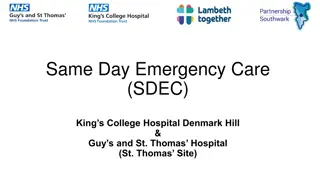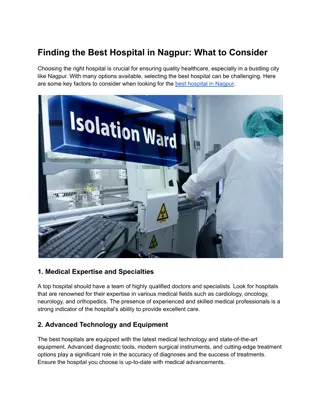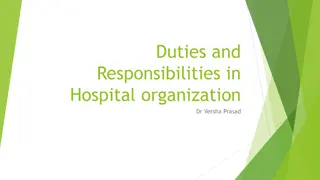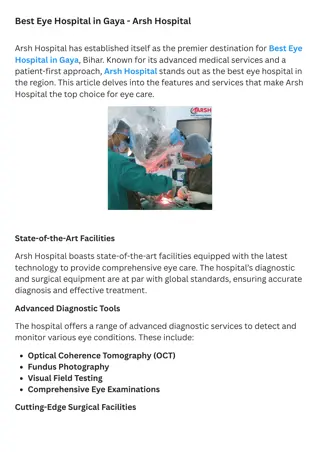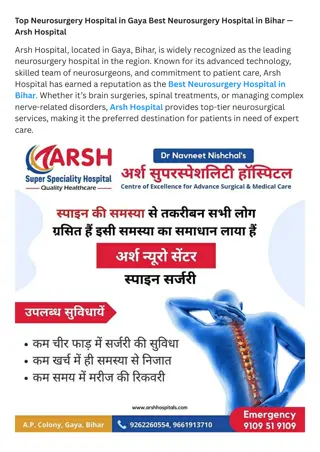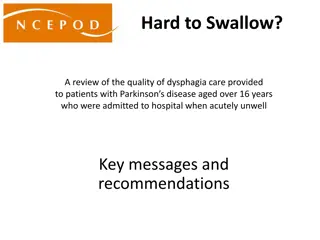Hospital Admission Orders and Levels of Care
Hospitals must review admission appropriateness as per CMS guidelines to receive payments. Physician certification of medical necessity and admission orders are crucial for hospital payments. Patients are admitted to hospitals based on observation or inpatient status, following the 2 Midnight Rule. Exceptions to the rule exist for certain medical and surgical cases. Knowing these rules and exceptions is essential in determining the initial level of care for patients.
Download Presentation

Please find below an Image/Link to download the presentation.
The content on the website is provided AS IS for your information and personal use only. It may not be sold, licensed, or shared on other websites without obtaining consent from the author.If you encounter any issues during the download, it is possible that the publisher has removed the file from their server.
You are allowed to download the files provided on this website for personal or commercial use, subject to the condition that they are used lawfully. All files are the property of their respective owners.
The content on the website is provided AS IS for your information and personal use only. It may not be sold, licensed, or shared on other websites without obtaining consent from the author.
E N D
Presentation Transcript
Admission status orders Karen Clark, MD FACP Medical Director Care Management and Utilization Review Professor of Internal Medicine
WVUH CMS Requires that hospitals review the appropriateness of all admissions as a condition of participation Hospitals in the US must not be excluded from participation with CMS in order to survive Inpatient admissions are paid through Medicare Part A Outpatient/observation services are paid through Medicare Part B Levels of Care: Inpatient; Observation; EXON; NOTA
Hospital Admission Order As a condition of payment for hospital services, physician certification of the medical necessity of an admission is required. The order to admit is a critical element of this physician certification, and is therefore also required for hospital payment All patients in a hospital bed must have an admission order to a specific level of care (LOC) or status
Levels of Care Most patients admitted to the hospital will be either admitted to an observation status or an inpatient status. CMS follows the 2 Midnight Rule as the basis to determine how to choose the LOC. Although all payers do not follow the 2 MN rule, we recommend you use this as the primary guide to chose the correct initial level of care
How to use the 2 MN rule to choose initial LOC Medical patients D/C likely tomorrow: observation D/C possible tomorrow: observation D/C definitely not tomorrow: inpatient Surgical patients D/C likely tomorrow: observation D/C possible tomorrow: observation D/C definitely not tomorrow: inpatient
2 MN rule exceptions Medical patients EXCEPTIONS: STEMI, NSTEMI; DKA; ESRD with K and EKG changes; unexpected need for mechanical ventilation Surgical patients EXCEPTIONS: Inpatient only list (IOL) surgery; Insurer gave an inpatient prior authorization; SDH
Other 2 MN exceptions Pt made CMO, Hospice, and/or dies Pt discharges AMA Pt transferred to another (higher LOC) acute care hospital
Other 2 MN exceptions Patient high risk and I expected 2 MN? Referred to as the case by case exception Requires the following: you document risk and an expectation the patient will stay 2 MN-- they get better earlier than you expected and are being discharged in less than 2 MN--you document they got better earlier than you expected
Other LOC: EXON Surgical or procedural patient being monitored longer than the designated time for post op recovery (up to 6 hours) Try to avoid this status as there is no payment for these patients UR will be looking at these cases for complications in order to assign an observation or inpatient LOC (we don t want EXON)
NOTA Not Appropriate for acute care: patient who remains in a hospital bed even though no clinical indication/need for acute hospitalization exists Try to avoid this as there is no payment for these patients Is a billing indicator meaning stop bill
Utilization Review Staff Behind the scenes performing ongoing reviews of the record Your documentation is critical to this process. Your thought process/decision making reflected in the record is essential RN assigned to your service Contact them (or me) with questions
Questions? Dr. Karen Clark kclark@hsc.wvu.edu 304-598-4602





